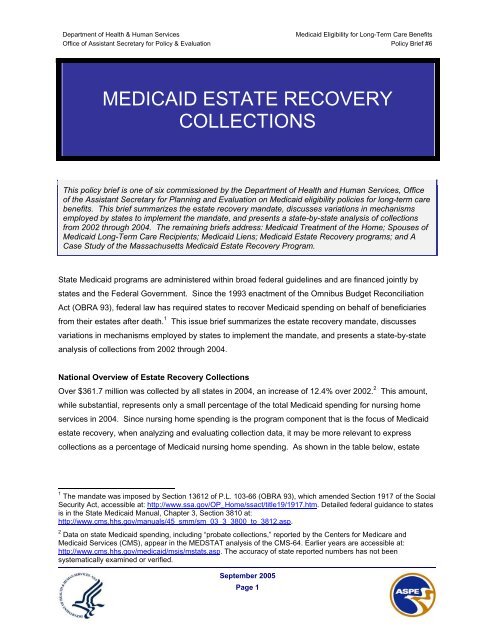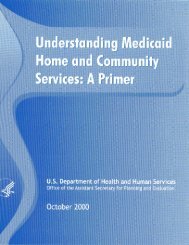Medicaid estate recovery collections - ASPE - U.S. Department of ...
Medicaid estate recovery collections - ASPE - U.S. Department of ...
Medicaid estate recovery collections - ASPE - U.S. Department of ...
Create successful ePaper yourself
Turn your PDF publications into a flip-book with our unique Google optimized e-Paper software.
• Recoveries may not exceed the total amount spent by <strong>Medicaid</strong> on the individual’s behalf, nor theamount remaining in the <strong>estate</strong> after the claims <strong>of</strong> other creditors delineated in state law havebeen satisfied.Exceptions and special cases:• Estate <strong>recovery</strong> must be deferred (or waived, at the state’s option) if the recipient is survived bycertain close relatives – a spouse or a child under the age <strong>of</strong> 21, blind, or permanently disabled.• States must waive <strong>estate</strong> recoveries that would cause hardship. 5• States may pass laws that exempt certain types <strong>of</strong> property from <strong>estate</strong> <strong>recovery</strong> (for example thefamily homestead).• States participating in the Partnership for Long-Term Care, a project to encourage more relianceon private insurance coverage for long-term care, 6 may exempt some or all assets <strong>of</strong>policyholders from <strong>Medicaid</strong> <strong>estate</strong> <strong>recovery</strong>.Collections by StateAmounts collected by individual states are show in Table 1 and Table 2 below. Collections resulting from<strong>estate</strong> <strong>recovery</strong> activities vary widely from state to state, and changes in the amounts collected byindividual states over time are highly irregular.2004 High and Low State Collection Rates• The three states that recouped the largest share <strong>of</strong> their nursing home spending are Arizona(10.4%),* Oregon (5.8%), and Idaho (4.5%).• Five additional states recouped >2.0% <strong>of</strong> nursing home spending: Iowa (2.9%), Minnesota (2.8%),Wyoming (2.7%), Maine (2.5%), and Massachusetts (2.0%).• Three states reported minimal recoveries (rounding out to 0%): Louisiana, New Mexico, and Utah.• Four states did not report any <strong>estate</strong> recoveries: Alaska, Georgia, Michigan, and Texas.* Arizona’s <strong>estate</strong> <strong>recovery</strong> <strong>collections</strong>, as a percentage <strong>of</strong> nursing home spending, are not comparable toany other state because comprehensive prepaid managed care contracts dominate that state’s <strong>Medicaid</strong>program. Nursing home care provided under these contracts is not identified separately for reportingpurposes.5 The hardship exemption is described in greater detail in <strong>Medicaid</strong> Estate Recovery, a policy brief prepared for theHHS Office <strong>of</strong> the Assistant Secretary for Planning and Evaluation, at:http://aspe.hhs.gov/daltcp/reports/<strong>estate</strong>rec.htm. See also Section 3810.C. <strong>of</strong> the State <strong>Medicaid</strong> Manual.6 See http://www.hhp.umd.edu/AGING/PLTC/index.html for a description <strong>of</strong> the Partnership Program and links toindividual state programs and data. For overviews <strong>of</strong> current program activities in the four Partnership states(California, Connecticut, Indiana and New York), as well as actions taken by states wishing to participate in theprogram, see http://www.hhp.umd.edu/AGING/PLTC/partnership_post.pdf.September 2005Page 3
Most <strong>of</strong> the higher <strong>recovery</strong> states have more mature programs and long experience with <strong>estate</strong> <strong>recovery</strong>.Changes in Collection Rates Between 2002 and 2004*• National <strong>collections</strong> rose by over $40 million (12.4%).• State-specific changes in <strong>collections</strong> were roughly similar to the average change nationally in onlyfour states: California, Massachusetts, New York and South Dakota. Though their rates <strong>of</strong> increasewere close to the national average (12-13%), the increases in funds they collected comprisednearly one-third (30.1%) <strong>of</strong> the total increase in national <strong>collections</strong>. Similarly, their share <strong>of</strong> total<strong>collections</strong> in 2004 was just under one-third (30.0%).• All other state <strong>collections</strong> between 2002 and 2004 departed significantly from the national average.• Thirty-five states increased their <strong>collections</strong> between 2002 and 2004. The five states with thehighest percent increases were Kentucky (184.7%), Louisiana (100.0%), New Mexico (100.0%),Wyoming (90.8%), and Tennessee (85.1%).• Twelve states collected less in 2004 than in 2002. The five with the largest percent decreaseswere: Utah (-97.7%), Pennsylvania (-74.7%), West Virginia (-64.6%), Nevada (-64.3%) andMississippi (-57.4%).• Factors explaining volatile rates <strong>of</strong> change within a given state over time are speculative andinclude: programs in early and unsettled states <strong>of</strong> implementation; gains or declines in a smallnumber <strong>of</strong> relatively large <strong>estate</strong>s (which can have disproportionate effects on rates <strong>of</strong> change,especially in smaller states); and errors or inconsistencies in reporting.* See Table 1, Table 2, and Table 3.Reasons for Wide State Variations in Reported Estate Recovery ActivitiesVariations in implementation <strong>of</strong> federal <strong>recovery</strong> options:States can choose to implement the minimal <strong>estate</strong> <strong>recovery</strong> guidelines mandated by OBRA 93, or theycan implement a variety <strong>of</strong> options permitted by federal law to expand their <strong>estate</strong> <strong>recovery</strong> activities toreach more people and include more types <strong>of</strong> assets (see Table 4, below). For example, they can: useliens to secure <strong>Medicaid</strong>’s right to recover; recover from recipient assets that bypass probate; or recover<strong>Medicaid</strong> spending for additional services beyond the required minimum <strong>of</strong> long-term care and relatedservices.There appears to be only a weak connection between a state’s reported <strong>collections</strong> and the policy optionsit has chosen. Although states that exercise the fewest <strong>estate</strong> <strong>recovery</strong> policy options (e.g., Arkansas,Mississippi, New Mexico, North Carolina, Pennsylvania, Vermont, and West Virginia) tend to have thelowest rates <strong>of</strong> collection, some states have relatively low collection rates (e.g., Delaware or Oklahoma),despite having chosen a broad range <strong>of</strong> options to maximize collection opportunities. Clearly, factorsother than a state’s chosen policy options are also at work.September 2005Page 4
Administrative systems:An effective <strong>estate</strong> <strong>recovery</strong> program requires a commitment by the state to provide adequateadministrative resources, such as integrated information systems and/or trained staff.Actions taken by individuals to shelter their <strong>estate</strong>s:The more individuals in a state engaged in <strong>estate</strong> planning before death to protect their assets for heirs,ensure an income stream from retirement savings during life, or avoid inheritance taxes after death, themore they reduce the portion <strong>of</strong> their <strong>estate</strong> subject to <strong>recovery</strong> by claimants (including <strong>Medicaid</strong>) aftertheir death.Frequency and Size <strong>of</strong> Individual RecoveriesData about the size and numbers <strong>of</strong> <strong>estate</strong>s affected are exceedingly thin. Given the small amountsrecovered compared to total <strong>Medicaid</strong> spending, it is reasonable to surmise that <strong>Medicaid</strong> <strong>estate</strong> <strong>recovery</strong>is a relatively infrequent occurrence. A study conducted in Massachusetts (a state with a higher thanaverage collection rate, a total <strong>Medicaid</strong> population <strong>of</strong> over one million, and a <strong>Medicaid</strong> nursing homepopulation <strong>of</strong> over 33,000) 11 reports completion <strong>of</strong> the claims process for just over 1,600 claims on<strong>estate</strong>s in 2003.The change is sometimes leveled that <strong>Medicaid</strong> <strong>estate</strong> recoveries selectively target individuals with fewassets, while leaving those who have the most unscathed. 12 Given the strict asset limitations for<strong>Medicaid</strong> eligibility, 13 one might expect the typical deceased recipient’s <strong>estate</strong> to be very small, there issome limited evidence to corroborate that the <strong>estate</strong>s <strong>of</strong> most <strong>Medicaid</strong> recipients are small. It alsoappears that relatively few higher value <strong>estate</strong>s contribute a disproportionately large share to the total<strong>estate</strong> <strong>recovery</strong> <strong>collections</strong>. 14The most significant contribution to the high value <strong>of</strong> some <strong>estate</strong>s is made by the homes <strong>of</strong> <strong>Medicaid</strong>recipients, since the real <strong>estate</strong> equity in a recipient’s home during life is not considered during the11 See <strong>Medicaid</strong> Liens and Estate Recovery in Massachusetts, at: http://aspe.hhs.gov/daltcp/reports/MAliens.htm.12 See Schwartz, R.A. and Sabatino, C.P. (November 1994). <strong>Medicaid</strong> Estate Recovery Under OBRA ’93: Picking theBones <strong>of</strong> the Poor? For the Commission on Legal Problems <strong>of</strong> the Elderly, the American Bar Association.13 Recipients may own $2,000 in general savings ($3,000 for a couple), limited amounts <strong>of</strong> life insurance, burial funds,household and personal effects, and certain other types <strong>of</strong> assets. <strong>Medicaid</strong> rules generally mirror those <strong>of</strong> theSupplemental Security Income program (SSI). SSI rules on assets (“resources”) are available in the Code <strong>of</strong> FederalRegulations, Title 20, Part 416, Subpart L at: http://www.ssa.gov/supplemental-security-income/law-regs-finder.htm.14 The earliest and most detailed evidence is indirect and relates to recipients’ attempts to transfer assets beforedeath. See <strong>Medicaid</strong> Estate Planning. Letter from U.S. General Accounting Office to U.S. Senate, Committees onFinance and Aging. GAO/HRD-93-29R. July 1993.September 2005Page 6
<strong>Medicaid</strong> eligibility determination, regardless <strong>of</strong> its value. However, it may be subject to <strong>estate</strong> <strong>recovery</strong>after the recipient’s death. 15 Therefore, it is conceivable that some <strong>Medicaid</strong> recipients who have ownedhomes leave <strong>estate</strong>s that are larger than expected.It is difficult to assess the importance <strong>of</strong> the home to individual state <strong>Medicaid</strong> <strong>estate</strong> <strong>recovery</strong> programsbecause <strong>of</strong> their wide policy and procedural differences, with real <strong>estate</strong> accounting for about one-quarter16, 17, 18<strong>of</strong> <strong>estate</strong> <strong>recovery</strong> <strong>collections</strong> in some states to virtually the entire amount collected by others.Conclusion<strong>Medicaid</strong> <strong>estate</strong> <strong>recovery</strong> gets to the heart <strong>of</strong> the issue <strong>of</strong> who should pay for long-term care – the publicthrough the tax-supported <strong>Medicaid</strong> program, or users <strong>of</strong> long-term care through their personal resources,including those remaining after death. Amounts collected from <strong>Medicaid</strong> recipients’ <strong>estate</strong>s are notinsignificant in absolute terms. They do, however, pale next to total <strong>Medicaid</strong> spending for long-termcare. This is not surprising, given that <strong>Medicaid</strong> is available only to those with very limited resources.Nevertheless, the wide state-to-state variation in <strong>recovery</strong> rates and <strong>estate</strong> <strong>recovery</strong> practices suggeststhat program efficiency could be improved and greater amounts could be recovered.15 The home retains an exemption from <strong>estate</strong> <strong>recovery</strong> only if the recipient is survived by a spouse, a minor ordisabled child or, in limited instances, certain siblings or adult children living in the home. In all other cases, thedeceased recipient’s equity interest in the home may be subject to <strong>estate</strong> <strong>recovery</strong>.16 Data on home ownership rates or the value <strong>of</strong> homes belonging to <strong>Medicaid</strong> recipients have not been collectedsystematically. The fact that the <strong>Medicaid</strong> program typically serves low-income individual means that few recipientscan afford to own valuable real <strong>estate</strong>. However, recipients in nursing homes are not typical <strong>of</strong> the <strong>Medicaid</strong>population in general. They may qualify for <strong>Medicaid</strong> despite having incomes far above the poverty level, which mayhave enabled them to accumulate significant equity in a home.17 2002 <strong>Medicaid</strong> Estate Recovery Work Group Report to the Pennsylvania Intra-Governmental Council on Long-Term Care. See data tables 1 and 2. The results <strong>of</strong> this study were compromised because the number <strong>of</strong> states thatresponded fully was limited and the report failed to address the number <strong>of</strong> properties involved or the amount collectedper property.18 Karp, Sabatino, and Wood (May 2005). <strong>Medicaid</strong> Estate Recovery: A 2004 Survey <strong>of</strong> State Programs andPractices, accessible at: http://assets.aarp.org/rgcenter/il/2005_06_<strong>recovery</strong>.pdf.September 2005Page 7
StateTABLE 1: <strong>Medicaid</strong> Collections and Expenditures -- Fiscal Year 2004Collections:Probate FY 2004FY 2004 <strong>Medicaid</strong>Nursing HomeExpendituresSeptember 2005Collections as % <strong>of</strong>Nursing HomeSpendingState Nursing HomeSpending as % <strong>of</strong>National NursingHome SpendingAlabama $6,204,836 $766,521,275 0.8% 1.7%Alaska $0 $107,091,559 0.0% 0.2%Arizona $2,403,306 $23,172,901 10.4% 0.1%Arkansas $2,104,052 $540,193,697 0.4% 1.2%California $44,668,847 $3,033,946,724 1.5% 6.6%Colorado $6,241,993 $423,944,387 1.5% 0.9%Connecticut $8,204,283 $1,105,579,338 0.8% 2.2%Delaware $436,370 $158,840,995 0.3% 0.3%Florida $13,478,207 $2,250,455,672 0.6% 4.9%Georgia $0 $1,466,092,237 0.0% 3.2%Hawaii $1,684,280 $182,705,650 0.9% 0.4%Idaho $5,695,851 $126,613,061 4.5% 0.3%Illinois $21,254,742 $1,608,092,952 1.3% 3.5%Indiana $7,649,409 $948,116,230 1.8% 2.1%Iowa $12,194,616 $426,181,610 2.9% 0.9%Kansas $4,866,505 $344,645,407 1.4% 0.8%Kentucky $5,391,045 $627,317,272 0.9% 1.4%Louisiana $103,853 $593,234,878 0.0% 1.3%Maine $6,178,845 $248,697,265 2.5% 0.5%Maryland $5,456,547 $867,262,512 0.6% 1.9%Massachusetts $32,577,301 $1,617,497,416 2.0% 3.5%Michigan $0 $1,704,056,909 0.0% 3.7%Minnesota $24,999,595 $904,205,889 2.8% 2.0%Mississippi $391,933 $563,151,164 0.1% 1.2%Missouri $8,597,322 $789,726,442 1.1% 1.7%Montana $2,363,322 $164,145,366 1.4% 0.4%Nebraska $1,125,970 $359,714,726 0.3% 0.8%Nevada $420,429 $141,377,842 0.3% 0.3%New Hampshire $4,362,641 $276,085,727 1.6% 0.6%New Jersey $8,329,882 $1,479,889,851 0.6% 3.2%New Mexico $78,037 $179,818,250 0.0% 0.4%New York $29,953,334 $6,486,722,331 0.5% 14.2%North Carolina $5,529,652 $1,096,619,059 0.5% 2.4%North Dakota $2,000,766 $166,456,173 1.2% 0.4%Ohio $13,987,964 $2,722,643,741 0.5% 5.9%Oklahoma $1,573,913 $462,935,035 0.3% 1.0%Oregon $13,843,592 $238,642,419 5.8% 0.5%Pennsylvania $5,888,558 $4,069,955,523 0.1% 8.9%Rhode Island $2,792,488 $292,744,235 1.0% 0.6%South Carolina $6,206,820 $461,865,198 1.3% 1.0%South Dakota $1,222,693 $118,375,810 1.0% 0.3%Tennessee $8,895,934 $1,006,485,725 0.9% 2.2%Texas $0 $1,781,030,713 0.0% 3.9%Utah $47,443 $105,854,730 0.0% 0.2%Vermont $402,156 $104,364,396 0.4% 0.2%Virginia $776,866 $656,180,320 0.1% 1.4%Washington $10,770,875 $593,061,233 1.8% 1.3%Washington, D.C. $1,789,570 $188,211,034 1.0% 0.4%West Virginia $214,656 $367,149,385 0.1% 0.8%Wisconsin $16,772,729 $917,421,595 1.8% 2.0%Wyoming $1,632,368 $60,552,927 2.7% 0.1%United States $361,766,396 $45,835,646,786 0.8% 100.0%Page 8
















